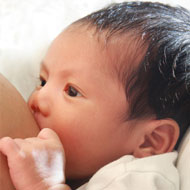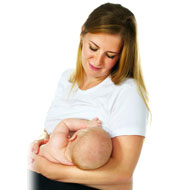What are the ways and Problems to Breatfeed a Newborn Baby?
Breastfeeding and suckling is nature’s way of nursing and feeding. Although it is natural, you can do a lot better with a little help. It is essential to make the experience comfortable and problem-free for both you and your baby.
To begin with, wash your hands well. It is advisable to wipe your breasts with a washcloth dipped in hot water. This will enhance milk flow and also cleanse the skin.
Then, choose a feeding position that is comfortable for you. It can be on your lap, the cradle hold, football hold (with the baby on your side), or you can recline with the baby lying on your side. You can use pillows to give support to your back and arms.
When to start Breastfeeding your new born baby
When you start breastfeeding a newborn, keep the baby close to you with its head, shoulders, and hips facing you and the baby’s mouth very close to your breast. Rub the baby’s lips with your nipple, and the baby will open its mouth to latch on, taking most of the areola in its mouth. You will feel the baby pulling your nipple and might have initial pain, which could last for a few seconds. If it lasts a little longer, remove the baby from the nipple and try latching on again. A breast feeding baby may start to cry when being moved about and so it is important to use quick smooth movements at this time.
Allow the baby to nurse on the first breast as long as it wants. Ensure that the milk flow is steady and the baby has had enough. Then, remove the baby from your breast by putting your finger in her mouth to release the suction.
Allow the baby to burp, and then allows it to nurse from your other breast. Tickle the baby under its feet if you find that your baby is feeling sleepy.
You can nurse the baby about 10 to 12 times in a day, or whenever the baby seems to be hungry. Crying or increased alertness will tell you that the baby is hungry. You will be feeding more frequently than those mothers who bottle feed because you will not be able to measure the amount of feed your baby consumes.
Breastfeeding your baby while baby teething
In about 4 to 6 months, your baby will start teething, and even before a tooth appears, you might get quite a nip. While they might sometimes take you by surprise, once they begin to nip, you can say a firm ‘no’ to the baby. The firm voice will reinforce the idea, and if you stop feeding momentarily, the baby will soon get the message. Remember that she is not doing it intently, but is trying to relieve the pain in the gums that is caused by teething. Breastfeeding a teething baby can be a little tricky at first but will get better with time. Give her a teething ring or a toy, which has been placed in the fridge as the cold will help bring relief from teething pain.


